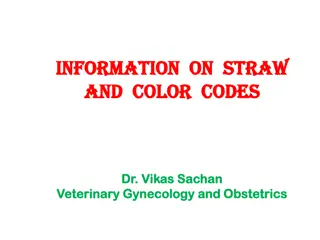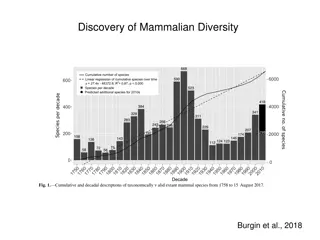Understanding Semen Dynamics and Capacitation in Mammalian Spermatozoa
Semen dynamics play a crucial role in mammalian reproduction, with capacitation being a key process for sperm fertilization capability. Capacitation involves physiological changes in sperm, leading to the acrosome reaction, crucial for oocyte penetration. As sperm transit through the epididymis, they acquire progressive motility and fertilization capacity over time in the female reproductive tract. Sperm tail and head changes, along with hyperactivation, are observed during capacitation, influenced by various factors like media constituents and intracellular messengers. In vitro sperm capacitation is supported by appropriate incubation conditions and involves events such as decapacitation factor removal. Understanding the intricate process of capacitation is vital for reproductive success.
Download Presentation

Please find below an Image/Link to download the presentation.
The content on the website is provided AS IS for your information and personal use only. It may not be sold, licensed, or shared on other websites without obtaining consent from the author. Download presentation by click this link. If you encounter any issues during the download, it is possible that the publisher has removed the file from their server.
E N D
Presentation Transcript
Semen Dynamics Dr. Pramod Kumar Department of Veterinary Physiology BVC, Patna
Capacitation It is a process that allows the acrosome reaction to occur, so, the sperm can penetrate the zona pellucida of the oocyte. The physiological changes that confer on the sperm the ability to fertilize are called Capacitation.
After leaving the testis, mammalian spermatozoa are morphologically differentiated but have acquired neither progressive motility nor the ability to fertilize a metaphase II arrested egg. During epididymal transit, sperm acquire the ability to move progressively, but they are still fertilization incompetent. Fertilization capacity is gained after residence in the female tract for a finite time.
Capacitation is also correlated with changes in sperm motility patterns, designated as sperm hyperactivation. Capacitation causes head changes (acrosome reaction) and tail changes (motility changes). Capacitation consists two components: (i) The first phase is referred to as capacitation. (ii) The second phase is referred to as acrosome reaction(AR).
Sperm tail changes after capacitation Cause of sperm capacitation- In vivo, the oviduct and uterus fluids capacitate the spermatozoa in different animals. In vitro, both caudal or ejaculated sperm capacitate when incubate under a variety of conditions in defined media.
In-vitro Sperm capacitation - The sperm cell is programmed to undergo capacitation when it is incubated in the appropriate medium. 1. Role of media constituents like, Serum albumin, Calcium, Bicarbonate 2. Effectors and intracellular messengers as Cyclic AMP metabolism, Protein tyrosine phosphrylation. Ejaculated spermatozoa - contains decapacitated agent.
Events in Capacitation Decapacitation factor removal Time dependent and are induced by binding of a capacitating agent Glycosaminoglycans - heparin or heparan sulfate Components of extracellular matrix of uterine and oviduct cells Induced by cholesterol removal Acceptor is albumin.
Role of media constituents - Serum albumin (BSA) during in-vitro capacitation remove cholestrol from sperm plasma membrane. Calcium: Increase in intracellular Ca during capacitation. Ca capacitate sperm with heparin requires extracellular calcium which decline the time required for capacitation increases. Bicarbonate: Transmembrane movement of HCO3 responsible for increase in intracellular pH that is observed during capacitation.
Intracellular second messengers Intracellular messenger mediating capacitation will be considered from two respective. The regulatory system appears to be common among different species. The regulatory process may be unique to one or more species. Cyclic AMP metabolism: The protein kinase A (PK-A) activity increases capacitation as a result of elevation intracellular cAMP. The mode of regulation of cAMP metabolism during sperm capacitation may be integrated with changes in Ca and HCO3 movement. during sperm
Protein tyrosine phosphorylation mediates a variety of cellular function and the increase in protein tyrosine phosphorylation is dependent on the presence of BSA, Ca and NaHCO3 in the medium. The role of protein tyrosine phosphorylation in sperm capacitation is regulated through a PK- A. Intracellular pH - The pH increase during sperm capacitation is done by heparin.
Membrane potential - Capacitation is accompanied by the hyperpolarization of the sperm plasma membrane and is due to enhanced potassium permeability. Free radicals - The free radicals has a role in sperm lipid peroxidation and sperm viability. Superoxide anion cause capacitation and hyperactivation of the spermatozoa. Reactive oxygen regulate protein tyrosine phosphorylation of several protein.
Heparin Bovine in-vitro sperm capacitation can be accomplished in media containing heparin. The active capacitating agent in the oviduct fluid is a heparin-like glycosaminoglycan. This may promote capacitation by binding to and removing seminal plasma protein. Heparin increases cAMP synthesis, elevate pH and regulate the capacitation-associated changes.
Glucose has inhibitory or stimulatory action on capacitation is controversial and is species dependent. In bovine, glucose inhibits heparin- induced capacitation in-vitro. Capacitation medium for mouse sperm, which contains glucose has no inhibitory effects.























